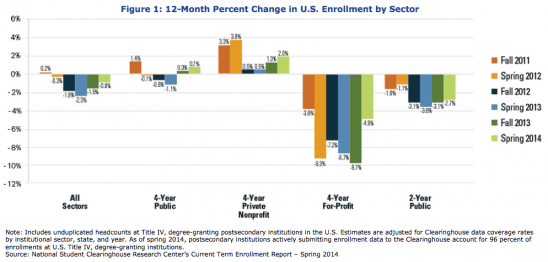U.S. college enrollment continued to decline in spring 2014, but at a slower rate than in recent terms, according to estimates from the National Student Clearinghouse (NSC) Research Center.
Nationally, the number of students enrolled in accredited two- and four-year colleges and universities decreased by 0.8% from spring 2013. This marks the smallest decrease since spring 2012, when enrollments shrunk 0.3%.
As the federal government’s Integrated Postsecondary Education Data System (IPEDS) does not collect spring enrollment data, this is considered the most current and accurate snapshot on postsecondary enrollment to date.
The changes vary greatly by institutional sector (Figure 1). Enrollment continued to decline at four-year for-profit institutions and two-year public institutions, by 4.9% and 2.7%, respectively.
Four-year public institutions reversed annual enrollment declines in recent years with a slight increase (0.7%) in spring 2014 enrollment. Private nonprofit institutions saw the greatest increase in enrollment with a 2% gain.
A sharp decline in adult student enrollment at both four-year for-profit and two-year public institutions seems to be fueling at least part of these sectors’ enrollment dips; enrollment of traditional-age students, on the other hand, grew by 0.7% overall.
Click chart to enlarge.
In New England, however, most states are bucking these national trends. While Rhode Island and Vermont’s enrollment patterns seem to closely mirror the nation’s slowing rate of decline over the past few years, the rest of the region has seen a mix of increases and decreases in spring enrollment (Figure 2). Most remarkably, New Hampshire has seen spring term enrollment increases in larger doses—from a 2.7% 12-month increase in spring 2012 to a more than 15% 12-month increase in spring 2014—a shift unmatched by any other state across the nation.
| Organization | Website | User name | Password | Notes |
|---|---|---|---|---|
| Association of Governing Boards (AGB) | https://agb.org | pmaguire@nebhe.org | 45temple | |
| Boston Business Journal | https://www.bizjournals.com/boston | info@nebhe.org | 45T3mp13 | |
| Boston Globe | https://www.bostonglobe.com | presidentsoffice@nebhe.org | 45t3mp13 | |
| Chronicle of Higher Education | https://www.chronicle.com | policy@nebhe.org | 45t3mp13 | |
| Constant Contact | https://login.constantcontact.com/login | nebhestaff | 45t3mp13 | |
| Hartford Courant | https://www.courant.com | wlindsay@nebhe.org | 1@NEBHE | |
| HERC | https://member.hercjobs.org/home | jharney@nebhe.org | 45T3mpl3 | |
| New York Times | https://www.nytimes.com | times@nebhe.org | NYTt3mp13 |
Click chart to enlarge.
NSC Research Center Executive Research Director Doug Shapiro commented that seeing the number of younger students beginning to grow again after a three-year decline is “encouraging” and could be part of resuming a “historic trend” but may not give New England higher education leaders much relief, as the number of traditional-age students in the region is projected to decline over the next decade.
New England states aiming to meet enrollment and degree-attainment goals would be wise to look beyond the student who enrolls immediately after high school. With this in mind, the Connecticut State Colleges and Universities system is implementing a buy-one, get-one-free course incentive for former students who return to higher education after stopping out, and the University of Maine System offers an Adult Degree Completion Scholarship with a similar mission. In the private sector, Southern New Hampshire University continues to build on its commitment to online- and competency-based education, aimed at easing the logistical burdens adult students often face in completing a degree.
Considering the trends illuminated in the recent NSC enrollment data and New England’s projected demographic changes, the arrival and support of these programs could not be more timely.
For more New England postsecondary enrollment data and analysis, see NEBHE’s recently revamped Trends & Indicators, which provides information on high-level enrollment trends and the opportunity to sort, filter and create customized analyses of disaggregated enrollment data.
Gretchen Syverud is policy research analyst at NEBHE.
[ssba]


